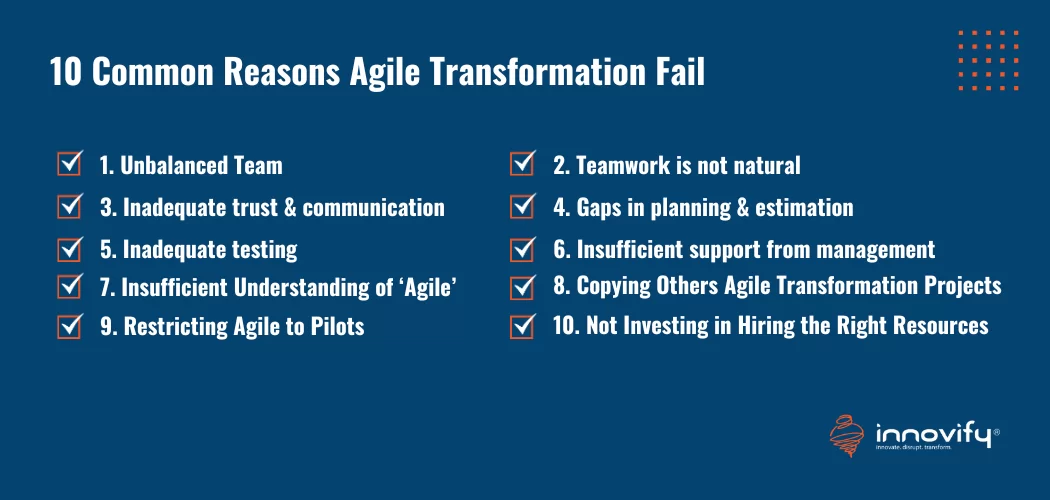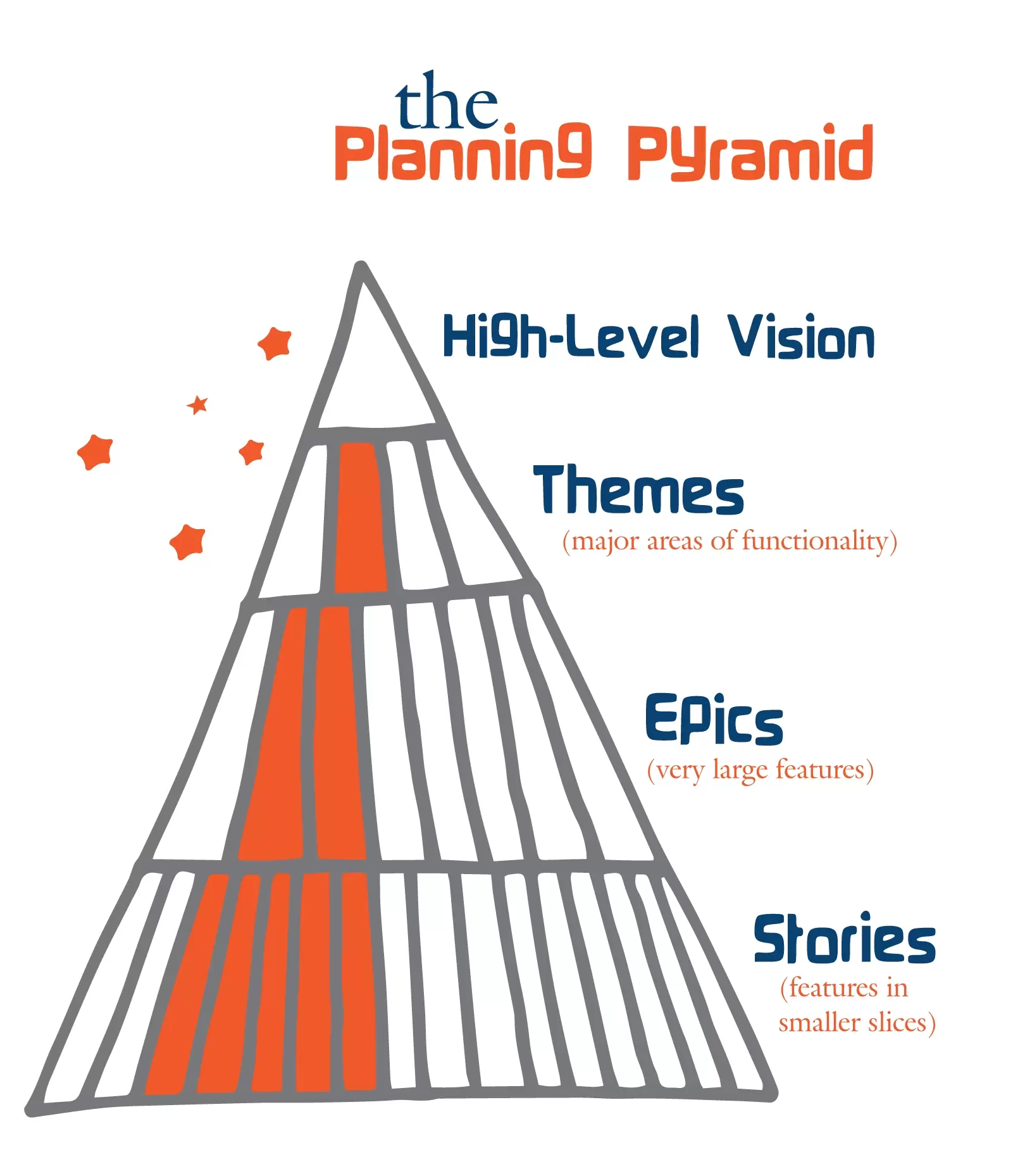Innovation
10 Reasons Why Agile Transformations Fail & How To Fix It
Many points should be considered while you transform any software development process into an Agile process; like team chemistry, team engagement, strong team maturity, communication, trust, top management support, continuous learning, and the list is countless. Listed are the most common points that make Agile a failure.
Agile revolves around the concept of ‘iterations.’ Software development involves creating products through incremental and iterative steps known as ‘Sprints.’ Adopting a practical product development approach, Agile enhances product quality and enables teams to prioritize users and core business objectives.
An agile transformation encompasses a complete organizational metamorphosis, shifting from rigid bureaucratic structures to more adaptable ones. It involves creating innovative and flexible environments that emphasize speed in execution. Empowering employees is a crucial element for achieving agility.
Product and software teams can accomplish this by engaging in frequent collaboration, seeking feedback, and releasing products. The transformation requires significant changes at an organizational level, including strategy, structure, processes, people, and technology. Embracing Agile practices can enhance value delivery, flexibility, and quality while transforming the organizational structure and decision-making processes.
It is concerning to note that, despite more than two decades since the introduction of the Agile Manifesto, 50-96% of Agile transformation processes fail due to the inability to adapt rapidly to market and environmental changes in a productive and cost-efficient manner. This failure rate for agile transformations is alarming indeed!
10 Common Reasons Agile Transformation Fail

1. Unbalanced Team
The role of a ScrumMaster: He involves himself in removing impediments that the development team might face, coaches the product owner & stakeholders, and keeps the development team away from all distractions. ScrumMasters should not dictate the team or micro-manage them. This may damage the team morale, create a lack of trust & also prevent the team from achieving their goals innovatively.
Opposite scenario is where the ScrumMaster is disengaged or uninvolved. In this situation, the person may only attend meetings, which leaves him clueless or unaware of what the team is doing.
The role of a Product Owner: This one is an important role. But due to lack of decision-making authority, training, & clarity, they don’t really understand the values and principles of the Agile process. This adversely affects the team.
The role of the Agile Team: Generally there are strong barriers between Dev and QA team members. There are conflicts between defect vs. improvement, defect logging process, providing stories to test at last moment etc. Teams should be self-managed & united with a clarity of ultimate goal i.e., successful sprint delivery.
Secondly, an understanding that everyone’s time is precious, the Dev team must deliver stories to QA team in a predictable manner which should be informed in daily scrum meetings.
2. Teamwork is not natural – it should be a continuous learning process
A team should constantly focus on how they work, making sure that stories get done, & on how processes can be improved. In general, people don’t get continuous training for this, & it is just assumed that the average developer can do it ‘naturally’ or training the team only once will give them an Agile mindset.
There is a giant leap from coding to owning the product development process. The team requires maturity & awareness of responsibilities. Some people just don’t care enough about how they contribute to an agile team – no matter how good they are at development.

3. Inadequate trust & communication
Trust: Fear’s mortal enemy is trust. A common example of fear stifling team growth is the issue of commitment. Teams often under commit or pad their estimates, due to fear of being responsible or blamed for failure. Initially, allow the team to give themselves permission to miss their estimations. Foster an environment of trust, such that the team can explore the causes of a miss without blaming. This helps you find the true upper limit of velocity. A single miss will translate into dozens of future successes.
Communication: If team members don’t talk to each other regularly, troubles lie ahead. Even with the most meticulous documentation, the best way to discover issues and blockers is through face-to-face communication. Foster collaboration by setting up a dedicated team area, where all team members work within reach of each other. Use video conference and instant messenger software to create a virtual room for global teams.
4. Gaps in planning & estimation
Some believe there is little or no planning with Agile. In fact, there is detailed planning. The difference with Agile is that planning is ongoing instead of a one-time event that gets signed off at the beginning of the development cycle, which occurs at varying levels of complexity and granularity.
Some teams relate user story points to actual working hours. Avoid this mistake! Use abstract values such as t-shirt sizes, animals, colors, or points to represent the size of new work. This is important.
Abstraction helps in tracking the complexity of the story instead of an individual’s availability. Point estimation reflects the abilities of the team as a whole. Once user stories are sized and committed for iteration, individual capacity comes into play in the form of hourly task estimates.
5. Inadequate testing
Agile isn’t about delivering software faster; it’s about delivering quality working software faster. The product owner shouldn’t accept completed work until it has been tested and meets the team’s definition of done along with the acceptance criteria. One way to combat poor testing habits is to place an emphasis on developing automatic testing. Test every single build until it passes. You may believe testing is done last, after developers complete coding. That is not so! With testers sitting on the cross-functional team, testing should be done simultaneously. After iteration planning, the requirements of the user story are known. Start building tests against the value the stories provide so that they may be verified as soon as the code is ready. This removes a potential bottleneck.

6. Insufficient support from management
Management’s support for Agile development is very crucial when there’s a lack of it, it becomes a common cause of software project failures. Management is sometimes surprised or unprepared for things to slow down as teams learn Agile. It may take years, not months, to implement Agile development fully into an organization.
Some senior managers think “Agile development is just a speed play. If we go Agile, we’ll get stuff done three times faster”. It has been observed that management’s focus on speeding up application releases without quality leads to heavy business losses. They must clearly understand technical debt — the accumulation of application flaws if the quality control does not occur. It’s important to be able to deliver software that provides value frequently and at a sustainable pace, means that speed takes second place to good QA practices that keep technical debt low; practices such as test-driven development, regression test automation etc. should be in use.
Agile transformation brings along with it organizational transformations. Agile requires change and continuous improvement, not just in development but also in all practices that touch products.
Command-and-control management styles do not work with Agile, they need to become facilitative in their approach to lead people. Openness, honesty and transparency in communication are the logical places to start.
7. Insufficient Understanding of ‘Agile’
The Agile Manifesto primarily pertains to software development and does not directly address broader business outcomes. In contrast, organizational agility refers to the ability to adapt to evolving market conditions, which was not the original intention.
CTOs often seek methods to expedite the development of the right products and achieve faster time-to-market. They initiate transformations within their engineering teams to enhance efficiency and mistakenly apply the same approach to their entire product development process, incorrectly claiming to implement an agile transformation. The emphasis on transforming the product development process is a significant factor contributing to the failure of agile transformations.
8. Copying Others Agile Transformation Projects
One reason for the failure of agile transformations is the tendency of organizations to copy another organization’s process. This often happens when an external agile coach is hired to define the transformation roadmap based on practices used elsewhere or when someone within the organization directly replicates a case study or video without considering their unique needs. Copying other organizations’ approaches this way is flawed and ineffective, leading to agile methodology failures.
Agile is about critical thinking, experimentation, and continuous improvement. It is essential to develop internal coaches who understand your organization’s specific requirements and priorities and to involve your employees in making informed decisions about the transformation. While external assistance may be necessary to kick-start the process, the ownership and adaptation of agile practices should come from within your organization.
9. Restricting Agile to Pilots
One of the reasons why agile transformations frequently fall short is that organizations need to allow them to pilot projects and adopt a wait-and-see approach. C-level executives need more than this limited scope to witness the potential impact of a more comprehensive agile transformation.
While it is acceptable to initiate the agile transformation within a small team or department, it is crucial not to halt progress and solely rely on the outcomes of pilot projects. Instead, cross-functional agile teams should embrace a holistic approach and infuse agile principles into the organization’s culture across all levels. It is through extending agile beyond small groups that the actual benefits and advantages can be realized.
10. Not Investing in Hiring the Right Resources
Building self-organizing teams is a core principle of agile, which necessitates hiring motivated and skilled individuals. The appropriate human resources serve as the driving force behind an organization’s agile journey. However, inadequate training and talent often stand out as the primary reasons for the failure of agile transformations. Team members need to recognize the importance of agile to achieve a successful agile transformation.
While every organization should establish a rigorous process for hiring the right talent, the agile team must maintain the ability to bring new people on board. Agile methodologies oppose micromanagement, so hiring individuals who can manage themselves and contribute value to the business is essential.
Here are some tips to consider before hiring individuals for your agile team:
- Focus on individuals, not just their skills. Agile teams should posses certain characteristics where every individuals should have the right personality, mindset, and values.
- Identify the intrinsic skills necessary for success in agile projects and determine where to find resources with such skills.
- Always strive, even if there is a sense of urgency to fill a position. Product owners should refrain from rushing the hiring process.
8 Tips to Fix Agile transformation failure
Agile project management is a popular approach organisations use to increase their ability to respond to changing market demands and customer needs. Despite its many benefits, some organizations struggle to implement agile practices successfully. Here are six tips to fix agile transformation failure:
1.Focus on Culture
Agile transformation is not just about implementing new processes and tools; it requires a cultural shift as well. Organizations that are successful with agile transformation and overcome its challenges prioritize culture and invest in creating an environment that values collaboration, feedback, and continuous improvement. Leaders should work to create a culture that encourages experimentation, risk-taking, and learning from failures. This means promoting an agile mindset throughout the organization, empowering people to make decisions and take ownership of their work.
2.Start with Small Changes
Agile transformation is a significant undertaking, and it’s easy to become overwhelmed by the scale of the effort. To avoid this, start with small changes that can be implemented quickly and easily. This can help to build momentum and show the benefits of agile transformation to the organization. As teams become more comfortable with the changes, they can gradually implement more significant changes to their processes.
3.Invest in Training
Agile transformation requires new skills and knowledge, and it’s essential to invest in training and development for employees. This includes providing training on agile methodologies, tools, and techniques, as well as training on soft skills such as collaboration and communication. Training should be tailored to the needs of the organization and should be provided to all levels of the organization, from executives to frontline workers.
4.Use Metrics to Track Progress
Metrics are essential for tracking progress and identifying areas for improvement. Organizations that are successful with agile transformation use metrics to measure their processes’ effectiveness and identify bottlenecks and areas for improvement. Metrics should be used to measure both quantitative and qualitative aspects of the process, such as cycle time, defect rates, customer satisfaction, and employee engagement.
5.Involve Stakeholders
Agile transformation affects the entire organization, and involving stakeholders in the process is essential. This includes executives, managers, employees, customers, and partners. Stakeholders should be involved in the planning process, and their input should be incorporated into the transformation effort. This helps to ensure that everyone is aligned with the goals of the transformation, and it provides a mechanism for collecting feedback and addressing concerns.
6.Continuously Adapt
Agile transformation is an ongoing process, and it’s essential to continuously adapt and evolve the processes to meet the changing needs of the organization. This means continuously evaluating the effectiveness of the processes, identifying areas for improvement, and making changes as necessary. It’s important to create a culture of continuous improvement where teams are encouraged to experiment and try new things.
7. Emphasizing Collaboration in the Transformation Process
Before embarking on an agile transformation, it is crucial to recognize that it must be a collaborative endeavour. Teams will play a central role in laying the groundwork for the transformation, and organizations will need to recalibrate their processes at every step.
Achieving end-to-end agility requires the active involvement of all departments, with isolation being strictly discouraged. It is advisable to establish comprehensive goals that consider the roles of all departments while keeping the overall transformation in mind. Shared ownership becomes the key to success. Organizations should prioritize open communication over hierarchical structures.
8. Overcoming Technological Barriers in Agile Transformation
Technological constraints are frequently the main obstacle to improving speed and quality. New product development is enhanced when traditional, non-cloud methods are abandoned to embrace modern technology. By adopting advanced technological solutions, organizations can establish a foundation that enables them to respond promptly to evolving customer needs and demands.
Ensuring both product quality and on-time delivery is crucial for the success of agile transformations. Harnessing the power of technology represents a significant stride in the journey of agile transformation.
How to Make Agile Work Better with Innovify
Agile methodologies are widely used in software development to improve productivity and deliver customer value faster. Innovify is a product management and software development company specialising in implementing agile methodologies to help businesses achieve their goals. Here are some ways to make agile work better with Innovify:
- Define clear goals and objectives: To make agile work better with Innovify, it’s important to define clear goals and objectives for the project. This helps to ensure that everyone is working towards the same goal and that progress can be measured effectively.
- Emphasize collaboration: Agile methodologies require collaboration between team members, stakeholders, and customers. Innovify places a strong emphasis on collaboration to ensure that all parties are aligned, and that feedback is incorporated throughout the project lifecycle.
- Focus on delivering value: One of the key principles of agile is to deliver value to the customer as early as possible. Innovify helps businesses to identify the most important features and functionality that will deliver value to customers and prioritize these in the development process.
- Use agile tools and techniques: Innovify uses various agile project management tools and techniques to help businesses manage their projects more effectively. These may include scrum boards, user stories, sprint planning, and retrospective meetings.
- Embrace continuous improvement: Agile methodologies are based on continuous improvement, and Innovify encourages businesses to embrace this mindset. By constantly evaluating and adjusting their processes, businesses can optimize their development cycles and deliver better products more efficiently.
By partnering with Innovify and implementing agile methodologies, businesses can improve their development processes, deliver value to customers faster, and achieve their goals more effectively.
Start Agile transformation with a pilot and build on its success. Learn from Innovify’s experience and we will be able to provide the necessary knowledge and proper coaching for future endeavors. Innovify is an end to end digital product management company with a focus on startups.
FAQs
Q1: Is there a timeline for an Agile Transformation?
The timeline for an agile transformation can vary depending on the organisation’s size, the complexity of the processes, the level of cultural change required, and other factors. Approaching agile transformation as an iterative and adaptive process rather than a fixed timeline is important.
Generally, an agile transformation is a journey that unfolds in stages, each building upon the previous one. It is recommended to start with pilot projects or teams to gain experience and gradually expand agile practices throughout the organization. Agile transformation is an ongoing effort that continues even after the initial implementation, as continuous improvement and adaptation are fundamental to the agile mindset.
Q2: Can an agile transformation fail even with strong leadership support?
While strong leadership support is crucial for the success of an agile transformation, it is not a guarantee of success on its own. Other factors, such as resistance to change, cultural barriers, inadequate training, or unrealistic expectations, can still hinder the transformation process. Leadership support must be accompanied by effective change management, addressing cultural challenges, providing proper training, and setting realistic expectations to mitigate the risk of failure.
Q3: Can an agile transformation fail if the teams are not adequately trained?
Yes, inadequate training can significantly impact the success of an agile transformation. Agile requires a different mindset and skill set compared to traditional approaches. If teams and stakeholders lack a proper understanding of agile principles, practices, and tools, they may struggle to adopt and implement agile methodologies effectively. It is essential to inspire the agile teams by providing comprehensive training programs that provide the necessary knowledge and skills are essential to support the transformation process and increase the chances of success.
Q4: What questions should be asked during the agile transformation?
An organisation should first understand the “why” behind the change process before posing the following questions:
- Challenges to be overcome
- Ability for restructuring
- The level of a cultural shift
- The framework for communication strategy is being applied
- Available tech stack and talent
- Process of preparing teams for transformation
- Progress measurement



